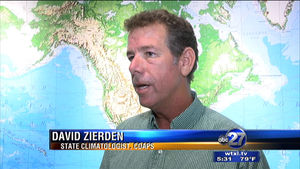-

September 2015 was cooler than normal for most of the Southeast, based on preliminary data through this morning. This was in stark contrast to most of the rest of the country, which was much warmer than normal. Precipitation across the Southeast varied quite a bit, with the Florida peninsula and areas of Georgia, Alabama and…
-

Another great map I found this week describes the spatial pattern of light pollution across the US (there are also maps for other countries available online). This map was described in an article in The Week magazine. The US map below shows the amount of light pollution across the US. The areas in green are…
-

As a climatologist and geographer I am always fascinated by the variety of maps that are available. You can measure the “climate” of many things, not just the weather. This week Matt Daniel, meteorologist at WMAZ in Macon, posted this map of the most active time for deer movement across Georgia from the Georgia Wildlife…
-

Rome Ethredge posted an article from Dr. Lenny Wells, UGA Extension Horticulturist, on the start of the pecan harvest this year in Georgia. This year’s crop looks to be one of the best we have had in the past several years and was aided by dry conditions in June which helped prevent scab in the…
-

Even though we are on the downside of the tropical season, it is not too late to get an impactful storm. Today Tropical Storm Joaquin is out in the Atlantic and may be headed for the North Carolina coast and the Northeast, where it could cause a lot of problems with flooding in the area.…
-

Considering the potential for rain across the eastern part of the country this week, particularly the Northeast, you might be interested in this NOAA interactive map on floods across the country. It lists significant floods for each state as well as information on flood safety and the different types of floods that can occur. You…
-

Because of the current El Niño, which is expected to last through the winter, heavy rain events of more than 2 inches in a day are twice as likely to occur than usual in the Southeast, according to Florida State Climatologist David Zierden. You can read an article and watch a video about his outlook at…